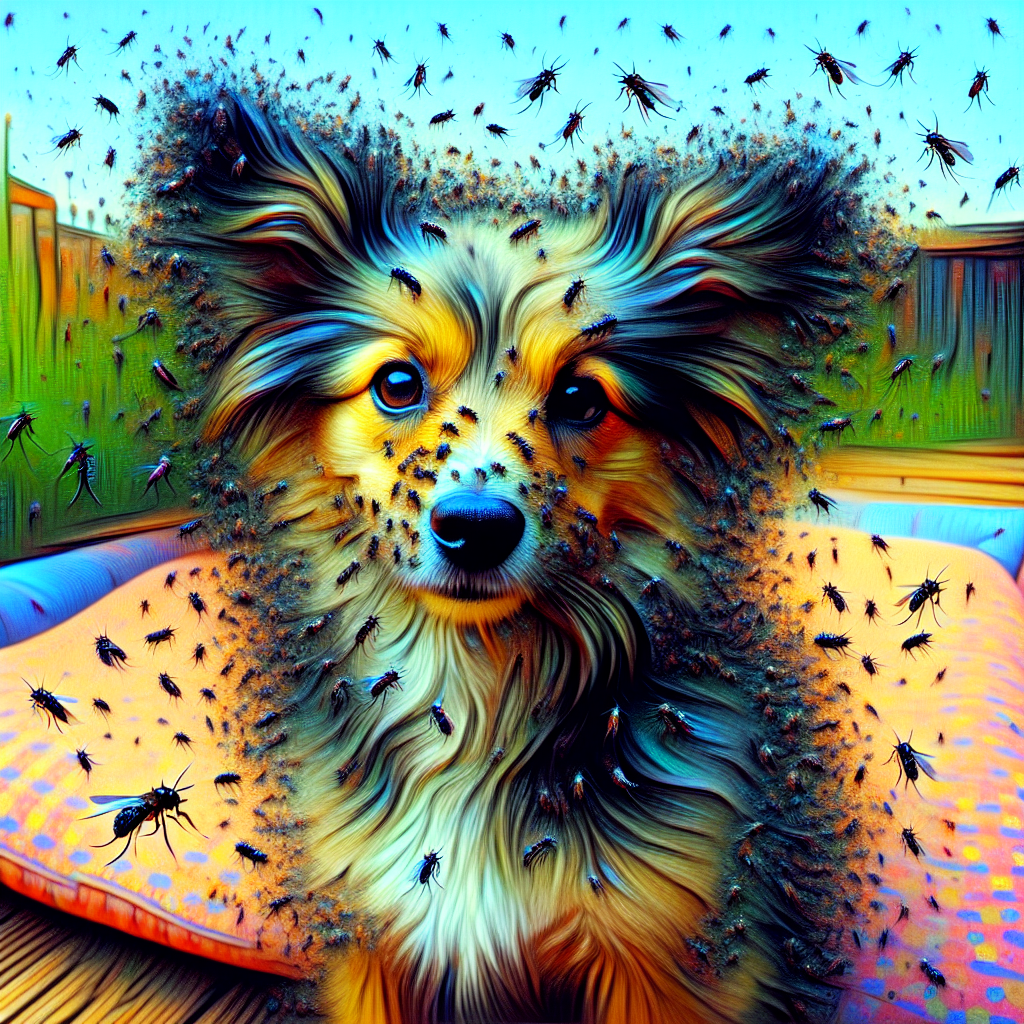Introduction to Flea Infestations: The Unwelcome Guests

Hey there, I’m Anna, and let me tell you, I’ve seen more than a few flea dramas in my day. Fleas are like that friend who never knows when to leave the party. They sneak in, and before you know it, they’re everywhere, making themselves at home. These little pests aren’t just an annoyance; they’re a full-blown battle. When you talk about a flea infestation introduction, you’re diving into a world of tiny invaders that can turn your cozy home upside down.
Fleas might be small, but they pack a punch. They aren’t just content with making your pets itch; they’re out for blood. Once inside your home, these pesky hitchhikers have no intention of leaving without a fight. And trust me, it’s a fight you need to be prepared for. Understanding how to safely kill fleas in home environments is crucial. It’s not just about reclaiming your comfort—it’s about protecting your family and pets from these unwelcome guests.
Understanding the Flea Lifecycle: Know Your Enemy
Now, before you can kick these intruders out, you gotta know your enemy, right? Fleas go through a sneaky little lifecycle with four stages: egg, larva, pupa, and adult. It sounds simple, but each stage has its challenges. Once you get the hang of understanding flea lifecycle, you can tackle them at every turn.
Fleas start as eggs, which are so tiny you can barely see them. They then hatch into larvae, which wiggle their way into the dark corners of your home, munching on organic debris. Next, they spin a cocoon and become pupae, waiting for the perfect moment to emerge as adults. This cycle can happen in a matter of weeks, and before you know it, you’re dealing with a full-blown infestation.
Knowing this lifecycle is your secret weapon. If you want to know how to safely kill fleas in home settings, you have to hit them at each stage. This means regular cleaning, vacuuming, and using treatments that target not just adult fleas but their eggs and larvae too. It’s not just about scratching the surface; it’s about getting to the root of the problem.
Signs Your Home Has Fleas: What to Look For
So, how do you know if these unwanted guests have moved in? Fleas are sneaky, but they leave a trail. The first thing you might notice is your pet scratching more than usual. It’s like they have an itch they can’t quite reach. That’s one of the first signs of fleas in home environments. But it doesn’t stop there. You might also find tiny black specks, known as flea dirt, on your pet or around your home. It’s their telltale calling card.
Finding flea dirt is a red flag. It’s basically flea poop, which means they’re feeding on your pets. Gross, right? But it’s an important clue. You might also notice little bites on your own skin, especially around your ankles. If you’ve spotted these signs, it’s time to roll up your sleeves. Knowing these flea detection tips can help you act fast before they spread further.
Health Risks Posed by Fleas: More Than Just an Itch
Now, for the part that really makes your skin crawl—fleas aren’t just a nuisance. They pose serious health risks. We’re talking about more than just an itch. These little guys can carry diseases that affect both pets and humans. It’s crucial to understand the health risks of fleas and why it’s important to act quickly.
Fleas can transmit tapeworms and even more severe diseases. In pets, flea bites can lead to allergic reactions, causing intense itching and discomfort. In severe cases, it can even lead to anemia, especially in puppies and kittens. For humans, flea bites can cause allergic reactions and, in rare cases, transmit diseases like murine typhus. It’s not just about comfort; it’s about health.
Understanding flea-related health problems is key to motivating you to tackle the problem head-on. It’s not just about getting rid of an itch; it’s about protecting your loved ones. Your goal should be to create a safe, flea-free environment for everyone involved.
Initial Steps to Address Flea Infestations: Getting Started
Alright, so you’ve spotted the signs and know the risks. What’s next? The first steps to kill fleas in home settings involve a bit of elbow grease, but you’ve got this. First, treat your pets. This is crucial. There are various treatments available, from topical solutions to oral medications. Consult your vet for the best option for your furry friends.
Next, it’s time to clean house. Vacuum every nook and cranny. Fleas love hiding in carpet fibers and upholstery, so don’t skimp on this step. Wash your pet’s bedding and any fabrics they frequent in hot water. Remember, it’s a marathon, not a sprint. Consistency is key to winning this battle.
By starting with these steps, you’re on your way to showing fleas the door. It might seem daunting at first, but stick with it. You’re not alone in this fight. Together, we’ll tackle this infestation and reclaim your home. Thanks for sticking around, and here’s to a flea-free home!
Safe Cleaning Practices to Combat Fleas
Hey there, fellow pet lovers! If you’re knee-deep in the battle against fleas, you’re not alone. Let’s get into some cleaning tips that won’t just spruce up your home but will also send those fleas packing. Regular vacuuming is your new best friend. Yep, I’m talking about breaking out the vacuum a few times a week. Focus on carpets, rugs, and those sneaky little crevices where fleas love to hide. When you’re done, make sure to empty the vacuum bag far from your home. Trust me, you don’t want a flea reunion on your hands. This kind of home cleaning to kill fleas is a simple yet effective step in your arsenal.
Now, let’s not forget about washing. Toss pet bedding, blankets, and even your own bedding into the wash on a hot cycle. Heat is a flea’s worst enemy. And if you’ve got hardwood or tile floors, a good mop with hot, soapy water can do wonders. It’s all about creating an environment that’s as unwelcome to fleas as possible. Remember, the cleaner your home, the less likely fleas will stick around.
Natural Remedies: A Flea-Free Home Without Chemicals
If you’re like me, you might be looking for ways to keep your home flea-free without resorting to harsh chemicals. There are natural flea remedies for the home that can work wonders. Diatomaceous earth is a classic go-to. Sprinkle it lightly on carpets, let it sit for a day, then vacuum it up. It’s safe for pets but deadly for fleas. Just be sure to use food-grade quality.
Essential oils can also be a part of your chemical-free flea control strategy. Oils like cedarwood and lavender are known to repel fleas. However, a word of caution here—some oils can be harmful to pets, especially cats. Always do a bit of research or consult your vet before you start diffusing or applying oils around your pets.
Another natural method? Try making a homemade flea trap with a shallow dish of soapy water under a nightlight. Fleas are attracted to the light and drown in the soapy water. It might not solve a large infestation, but it’s a neat trick for catching a few stragglers. Going natural doesn’t mean you have to compromise on effectiveness.
Choosing the Right Flea Treatments for Your Pet
Choosing the best flea treatments for dogs can feel daunting, but it doesn’t have to be a maze. Start with a chat with your vet. They’re the experts and can provide advice tailored to your pet’s specific needs. There’s a range of options out there, from chewable tablets to topical solutions. Some of these can start working in as little as 30 minutes. That’s fast relief for your itchy pup.
Oral treatments are often favored because they don’t wash off and can protect against multiple parasites, not just fleas. But if your pet hates taking pills, a topical treatment applied to the back of the neck might be a better fit. It’s all about finding what works best for your lifestyle and your pet’s comfort. And remember, even if you find a treatment that works wonders, it’s important to stick to a regular schedule as part of your flea prevention strategy.
How to Create a Flea Prevention Plan
Prevention is better than cure, right? So, let’s talk about creating a flea prevention plan. Start with regular checks. A quick comb-through with a flea comb can help catch any uninvited guests early. If your pet spends a lot of time outdoors, consider monthly treatments year-round. Even when it’s not flea season, these critters can still be a threat.
Consider the environment too. Fleas thrive in warm, humid areas, so keeping your home cool and dry can help. And if you’ve got a garden, keeping the grass short and trimming back bushes can reduce flea habitats. Your flea prevention strategy should be a combination of regular checks, environmental controls, and consistent use of preventive treatments.
What to Do If the Infestation Persists
Sometimes, despite our best efforts, those pesky fleas just won’t quit. If you’re dealing with stubborn flea infestations, don’t lose hope. It might be time to call in the pros. Pest control experts can offer more heavy-duty solutions if natural and over-the-counter methods aren’t cutting it.
While waiting for the pros, consider re-evaluating your approach. Are you applying treatments correctly? Regularly? If not, this might be an opportunity to tighten up your routine. Also, check in with your vet again—sometimes changing up the type of treatment can make a difference.
And remember, you’re not alone in this battle. Many pet owners have been in your shoes, and persistence is key. Keep at it, and those fleas will eventually get the hint. Thanks for sticking with me on this journey to a flea-free home. You’re doing great, and your pets thank you for it. Keep up the good fight, and remember, you’re not alone in this. Happy flea-fighting!
Understanding the Flea Life Cycle
Alright, let’s kick things off with a little science lesson. Fleas, those tiny pests that make our pets itch like there’s no tomorrow, have a life cycle that’s as fascinating as it is frustrating. Understanding these flea life cycle stages is crucial if you want to safely kill fleas in your home. Why? Because if you don’t know your enemy, how can you beat them?
Fleas go through four stages: egg, larva, pupa, and adult. It’s during the pupa stage, wrapped in a cocoon, that they’re most resistant to treatments. So, timing is everything. Catching them when they’re most vulnerable can save you a lot of hassle later. Those little critters can lay up to 50 eggs a day! Imagine that—just one flea can lead to a full-blown infestation in no time.
Knowing these stages helps us target the right time to attack, making sure we’re not just scratching the surface but actually dealing with the root of the problem. So, when planning how to safely kill fleas in your home, keep this in mind. Timing is your secret weapon.
DIY Home Remedies: Do They Work?
Now, let’s talk about those home remedies for fleas. I’ve heard it all—everything from vinegar to lemon spray. Some folks swear by them, but do they actually work? Well, it’s a mixed bag. Some remedies might have a slight effect, but others? They’re about as effective as a chocolate teapot.
Take vinegar, for example. It’s been touted as a natural flea repellent. But, while there’s some evidence that fleas don’t like the smell, it doesn’t necessarily mean they’ll pack up and leave. Same goes for essential oils like lavender or cedarwood. They might deter fleas a bit, but won’t eliminate an infestation. Plus, some oils can be harmful to pets, so tread carefully there.
If you’re determined to go the natural route, you might try mixing a little dish soap with water in a bowl, creating a flea trap. The fleas jump towards the light and get stuck in the soapy water. It’s not a magic bullet, but it can help reduce numbers.
The takeaway? While DIY can be part of your strategy, don’t rely solely on home remedies for fleas. They might help, but they’re not a standalone solution when you’re figuring out how to safely kill fleas in your home.
The Role of Regular Cleaning in Flea Control
Alright, let’s get down to cleaning. Regular vacuuming for flea control is an absolute must. It’s one of the simplest yet most effective ways to tackle those pesky fleas. Fleas hate cleanliness like I hate Mondays, so keeping your home spick and span is key.
Vacuuming your carpets, rugs, and even your furniture helps to suck up fleas in all stages of their life cycle. Pay special attention to areas where your pets hang out. And don’t forget to empty the vacuum bag or canister into a sealed bag right after.
Washing your pet’s bedding frequently, in hot water, is another crucial step. Fleas and their eggs can hide in the fabric, so regular cleaning helps keep them at bay. By maintaining a clean home, you’re not just tackling fleas but also preventing future infestations.
It might seem like basic chores, but believe me, regular cleaning for flea prevention is your secret weapon in the fight against fleas. It’s a simple, cost-effective method that makes a big difference.
Consulting Your Vet: Expert Advice
Now, let’s chat about the real experts—vets. Consulting your vet for advice on flea prevention and treatment is invaluable. They’ve seen it all, from the mildest cases to full-blown infestations, and they know what works best for your furry friend.
Vets can recommend treatments that are safe and effective, tailored to your pet’s specific needs. Whether it’s topical treatments, oral medications, or even injections, they’ll have the best vet advice on flea prevention. Plus, they can guide you through any potential side effects and ensure your pet is getting the right dosage.
Don’t hesitate to reach out to them. I mean, they’re like a treasure trove of information when it comes to keeping fleas at bay. They can also help you figure out the best times to treat your pet, considering their lifestyle and environment.
Your vet’s guidance is key in learning how to safely kill fleas in your home. Trust their expertise and lean on them for support. After all, they’re in your corner, rooting for your pet’s well-being just as much as you are.
Preventing Future Infestations
Finally, let’s talk prevention. Because, as the saying goes, prevention is better than cure. Once you’ve tackled the current flea problem, you’ll want to make sure it doesn’t come back. So, here are a few flea infestation prevention tips.
First up, regular flea treatments are a must. Whether it’s monthly topical applications or oral tablets, stay consistent. This regular preventive care acts like a “no vacancy” sign for fleas, keeping them from setting up shop again.
Keeping your yard tidy is also important. Fleas thrive in tall grass and debris, so keeping your lawn mowed and free of clutter can help. And if your pet spends a lot of time outdoors, consider using yard treatments that are safe for them.
Finally, keep up with that regular cleaning routine. It’s not just about dealing with an active infestation; it’s about preventing one from starting. Vacuuming and washing are simple, yet effective strategies to ensure fleas don’t return.
Thanks for sticking with me through this flea saga. Remember, you’ve got this! Keep that chin up, and give your pup a scratch from me. Cheers!
Quick Takeaways:
Hey there, it’s Anna again! So, we’ve been chatting about how to safely kill fleas in your home, and let me tell you, it’s a journey worth taking. First, get to know these tiny invaders. The flea lifecycle has four stages: egg, larva, pupa, and adult. This knowledge is your secret weapon in tackling fleas at every stage. When those little critters start making themselves known, you’ll probably notice your pet scratching more than usual. Or maybe you’ll find little black specks—flea dirt—on their bedding. These are signs of a flea infestation introduction that you don’t want to ignore.
Now, fleas aren’t just annoying; they can be downright dangerous. They carry diseases that can affect both pets and humans. So, the first steps to kill fleas in your home are crucial. Start with your pets by using vet-recommended treatments. Then, move on to your living space. Regular vacuuming and washing of bedding are essential. Flea detection tips? Keep an eye on your pet’s behavior and check their fur often.
For those who prefer a natural approach, there are remedies like using diatomaceous earth or specific essential oils. But remember, always check what’s safe for your furry pals. And hey, prevention is key. Set up a flea prevention strategy that fits your lifestyle. It’s like setting a no-trespassing sign for fleas. You’ve got this, and your pets will thank you!
FAQs:
1. How can I tell if I have a flea infestation in my home?
Spotting a flea infestation introduction is all about observation. Look for signs of fleas in your home like itchy pets, tiny black specks on bedding, or even small red bites on your skin. Fleas are sneaky, so it’s important to regularly check your pets and their favorite hangouts for any signs of these pesky insects.
2. What are some natural ways to safely kill fleas in my home?
If you’re leaning towards a natural route, you’re not alone. Many folks opt for diatomaceous earth, which can be sprinkled on carpets and pet bedding. Essential oils like cedarwood can also help, but always ensure they’re pet-safe. The goal is to find a balance between effective flea control and keeping your pets safe.
3. Why is understanding the flea lifecycle important in controlling an infestation?
Knowing the flea lifecycle—egg, larva, pupa, adult—gives you an edge. By targeting fleas at each stage, you can more effectively break their reproductive cycle. This means fewer fleas in the long run and a quicker return to normalcy for you and your pets.
4. What health risks do fleas pose to pets and humans?
Fleas aren’t just an itchy nuisance. They can transmit diseases like tapeworms and even certain types of bacteria that lead to more serious health issues. It’s not just about comfort; it’s about protecting your family’s health. That’s why how to safely kill fleas in your home becomes a priority for pet owners.
5. Are chemical-free flea treatments effective?
Chemical-free flea control can be effective but often requires more effort and consistency. Regular cleaning, vacuuming, and natural remedies can help manage fleas without harsh chemicals. However, for stubborn infestations, consulting a vet for additional treatment options might be necessary.
Conclusion:
Alright, folks, there you have it—your guide on how to safely kill fleas in your home. It’s been a ride, hasn’t it? Fleas might be tiny, but they sure know how to make a big mess of things. Remember, understanding the flea lifecycle and early detection are your best friends in this battle. Keep an eye out for those tell-tale signs of fleas in your home, and don’t hesitate to take action.
Regular cleaning and vet-approved treatments are your frontline defenses. And if you prefer natural remedies, just ensure they’re safe for your pets. Prevention is your long-term strategy—think year-round protection. It’s like putting up a “No Vacancy” sign for those little pests.
Thanks for sticking with me through this flea-fighting journey. You’ve got this! Keep that chin up, and remember, a flea-free home is a happy home. Give your pets a big hug from me, and here’s to living itch-free! Cheers!
References:
1. [WebMD – Kill Fleas at Home](https://www.webmd.com/pets/kill-fleas-at-home)
2. [Healthline – How to Get Rid of Fleas](https://www.healthline.com/health/healthy-home-guide/how-to-get-rid-of-fleas)
3. [CDC – Fleas Section](https://www.cdc.gov/fleas/section-name/index.html)
4. [EPA – Controlling Fleas and Ticks Around Your Home](https://www.epa.gov/pets/controlling-fleas-and-ticks-around-your-home)
Our solution eradicates fleas on contact without harmful chemicals, ensuring a safe environment for your pets and family. Easy to use and highly effective, SayByeBugs helps you maintain a flea-free home. Learn more and order today at SayByeBugs.com
Our solution eradicates fleas on contact without harmful chemicals, ensuring a safe environment for your pets and family. Easy to use and highly effective, SayByeBugs helps you maintain a flea-free home. Learn more and order today at SayByeBugs.com








